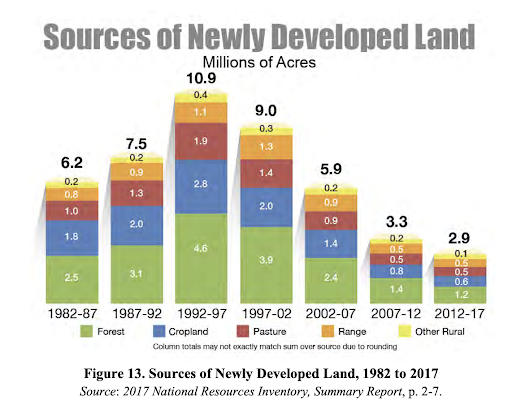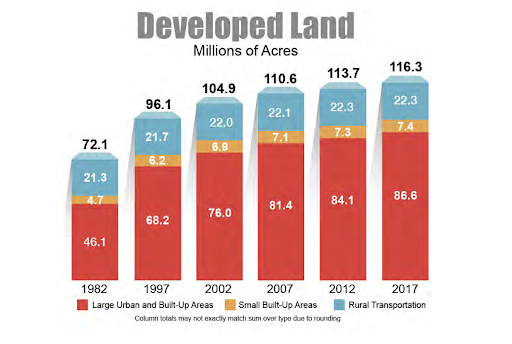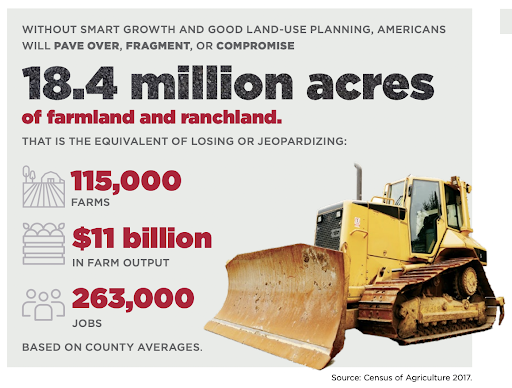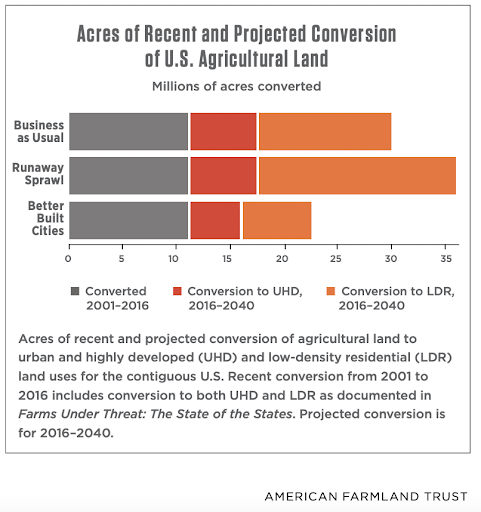America’s growing population is leading to the unilateral loss of farmland to make way for housing, office parks, shopping plazas, and more. The looming paradox is that as development consumes farmland to accommodate more people, the demand for food also grows. America’s capacity to provide basic resources (water, food, fiber) to its citizens is on a collision course with its population growth.
According to the latest data, in just 40 years more than 44 million acres of previously undeveloped land (an area larger than Florida) was paved over to accommodate our growing cities and towns. Much of that lost open space was once cropland, pastureland, or rangeland.

The good news, according to NumbersUSA’s study, is that the rate of open space loss has dramatically declined since peaking in the 1990s. According to the study’s authors, that’s “a reflection of increasing residential population density and also a response to the Great Recession of 2008 and its aftermath.”
Nevertheless, while the rate of loss has slowed, the total losses continue to mount, inevitably, as the population increases.


The 116 million acres of total developed land in America is equal in size to the 10 states of Maine, New Hampshire, Vermont, Massachusetts, Connecticut, Rhode Island, Delaware, New Jersey, New York, and Pennsylvania combined:
‘Asphalt is the land’s last crop,’ remarked former U.S. Assistant Secretary of Agriculture and conservationist Rupert Cutler back in the 1970s.
“Once a tract of farmland with its soils and the micro and macro-ecosystems they support are paved over, the probability of that patch of the Earth being restored within the foreseeable future to a functioning ecological habitat or productive agricultural land is miniscule.”
According to the American Farmland Trust’s report, “Farms Under Threat 2040, Choosing an Abundant Future,” the U.S. is projected to lose another 18.4 million acres of agricultural land between 2016 and 2040.

“It is urgent to safeguard the land that grows our food,” the report states:
But farmland and ranchland do so much more than just feed us. With good stewardship, these lands can also sequester carbon in the soil, protect water quality, and provide habitat for diverse wildlife and native species. Every acre counts. Yet, Americans are still paving over agricultural land at a rapid pace. From 2001—2016, our nation lost or compromised 2,000 acres of farmland and ranchland every day.”
American Farmland Trust recommends “compact development” (i.e. density, or “smart growth”) to slow the loss of agricultural land. Beyond the short term, however, they can only hope to slow the loss of farmland growth — not stop it — if the national population continues to increase by more than two million people each year.

In the long-term, federal immigration policy is projected to drive nearly all future population growth. Thus, the ultimate fate of American agriculture is in the hands of federal policy makers.

NumbersUSA’s one-pager on food security concludes:
Immigration levels today are not sustainable, and they are far above historical averages. Crafting a sensible population policy means enacting a policy of controlled immigration that is in the national interest. The United States can continue to have a generous immigration policy at the same time we work towards population stability. The choice is ours to make.
Much of the debate over U.S. immigration policy ignores what’s most important. Remember, it’s about the Numbers.”
JEREMY BECK is a V.P., Deputy Director for NumbersUSA